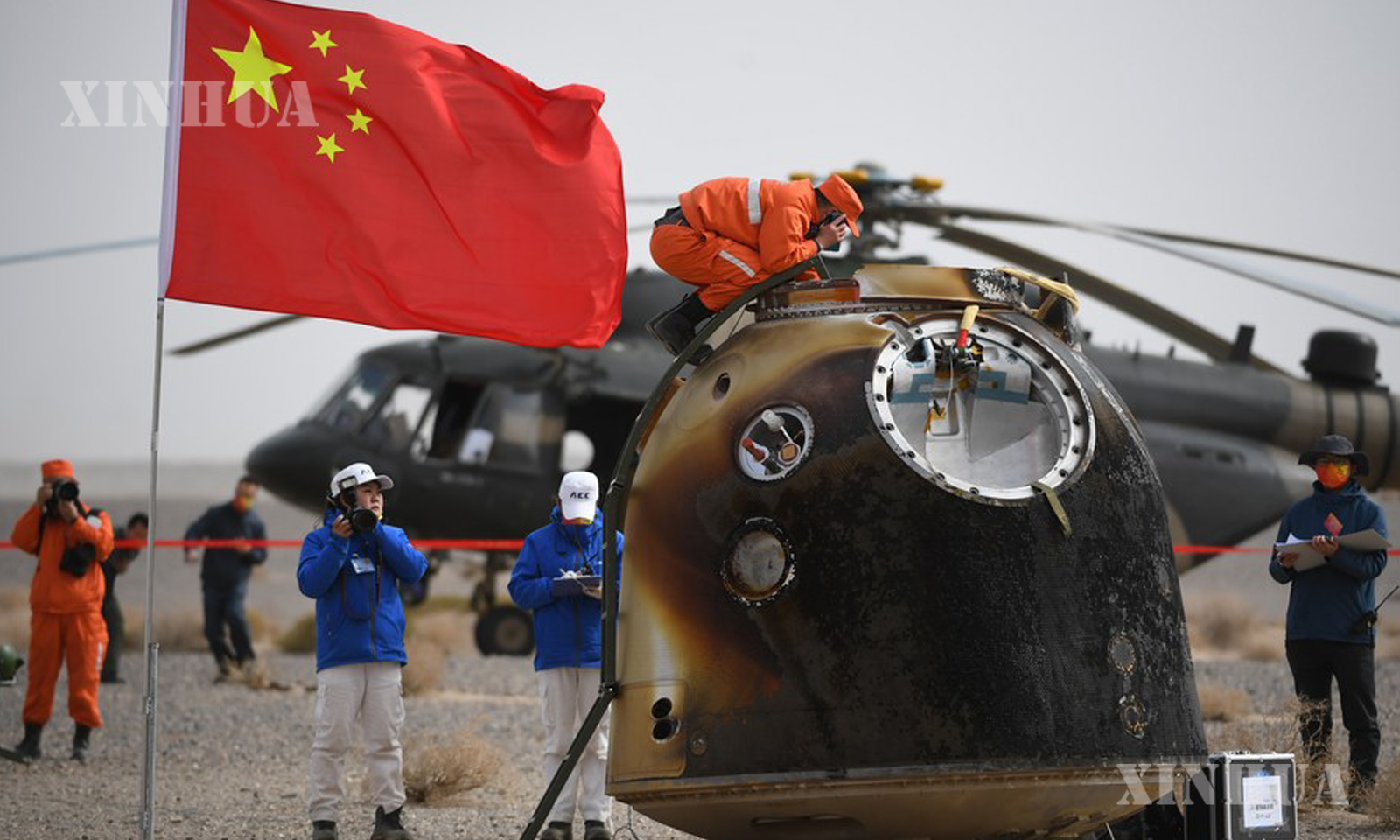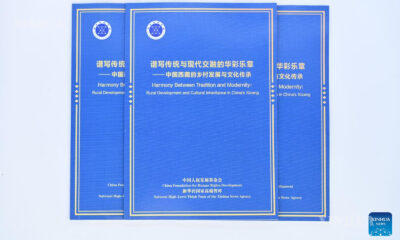Science & Technology
အာကာသယာဉ်၏အပူထိန်းလွှာအသစ်အား တရုတ်နိုင်ငံက တီထွင်

ပေကျင်း၊ ဇွန် ၂၀ ရက်(ဆင်ဟွာ)
တရုတ်နိုင်ငံ သိပ္ပံပညာရှင်များက လူလိုက်ပါအာကာသယာဉ် Shenzhou-14အတွက် သတ္တုအခြေခံ အပူထိန်းလွှာကို တီထွင်ခဲ့ရာ ၎င်းမှာ အာကာသယာဉ်မှူးများ ဂြိုဟ်ပတ်လမ်းအတွင်း ၆ လကြာနေထိုင်ချိန်ကာလအတွင်း အပူလွန်၊အအေးလွန်ခြင်းဒဏ်မှ ကာကွယ်နိုင်မည် ဖြစ်ကြောင်း သိရသည်။ယင်းအပူထိန်းလွှာအသစ်သည် နေအပူစွမ်းအင်ကြောင့် အာကာသယာဉ်အတွင်းရှိ အပူချိန်သက်ရောက်မှုကို လျှော့ချစေရန်အတွက် နေအပူစွမ်းအင်စုပ်ယူမှုကို လျော့နည်းစေခြင်း၊ အတွင်းပိုင်းအရင်းအမြစ် အပူထုတ်လွှတ်မှုကို ဟန့်တား၍ အနီအောက်ရောင်ခြည် နည်းပါးစွာ ထုတ်လွှတ်မှုကို ပံ့ပိုးပေးခြင်း ဟူသော လုပ်ဆောင်ချက်နှစ်မျိုးရှိကြောင်း သိရသည်။
Shenzhou-14ရှိ အာကာသယာဉ်မှူးများ၏ တာဝန်မှာ တရုတ်နိုင်ငံ ကောင်းကင်ဗိမာန်”Tiangong” အာကာသစခန်းကို ပြီးမြောက်အောင် တည်ဆောက်ခြင်း ဖြစ်ရာ ၎င်းတို့၏ ၆ လကြာ ခရီးစဉ်တွင် ရှုပ်ထွေးလှသော ဖွဲ့စည်းတည်ဆောက်မှုများကို မျက်မြင်သက်သေပြုသွားမည် ဖြစ်သည်။ အာကာသစခန်းပင်မခန်းနှင့်ချိတ်ဆက်သည့် ကုန်တင်အာကာယာဉ်အခန်းနှင့်ဓါတ်ခွဲခန်းအာကာသယာဉ်အခန်းတို့သည် လူလိုက်ပါအာကာသယာဉ်၏နေရောင်ခြည်ကို ဖုံးကွယ်နိုင်ခြင်းကြောင့် အလွန်အမင်းအေးစက်သော နက်ရှိုင်းသောအာကာသ၏အရိပ်အောက်တွင် ရေရှည်တည်ရှိနိုင်သည်။ ထို့အပြင် အာကာသယာဉ်သည် အာကာသပြင်ပ အလွန်အမင်း ပူပြင်းသော နေရောက်ခြည်၏တိုက်ရိုက်ကျရောက်မှုဒဏ်ကိုလည်း ရင်ဆိုင်ရမည်ဖြစ်သည်။
အပူထိန်းအလွှာမရှိပါက အာကာသယာဉ်၏ နေဘက်သို့ မျက်နှာမူရာအခြမ်းသည် အပူချိန် ၁၀၀ ဒီဂရီ စင်တီဂရိတ်အထက် ရှိနိုင်ပြီး အရိပ်ကွယ်ရာအခြမ်းသည် အနုတ် ၁၀၀ ဒီဂရီ စင်တီဂရိတ် ရှိမည် ဖြစ်သည်။ အပူချိန် မြင့်လွန်းခြင်း၊နိမ့်လွန်းခြင်းဖြစ်သော ပတ်ဝန်းကျင်သည် အာကာသယာဉ်မှူးများ၏ ကျန်းမာရေးနှင့်အာကာသစခန်းလည်ပတ်မှုအတွက် စိန်ခေါ်မှု ဖြစ်သည်။
တရုတ်အာကာသသိပ္ပံအကယ်ဒမီမှ တီထွင်ထုတ်လုပ်သော အပူထိန်းလွှာကို ၂၀၂၁ ခုနှစ် အောက်တိုဘာ ၁၆ ရက်က လွှတ်တင်ခဲ့သော Shenzhou-13 လူလိုက်ပါအာကာသယာဉ်တွင် ပထမဆုံးအသုံးပြုခဲ့သည်။
၆ လကြာ အာကာသခရီးစဉ်တွင် ၎င်းသည် လက်ခံနိုင်သော အပူချိန်အတိုင်းအတာ(၁၈ မှ ၂၆ ဒီဂရီစင်တီဂရိတ်ကြား)ကို ထိန်းထားနိုင်ရာ ဂြိုဟ်ပတ်လမ်းအာကာသစခန်းတွင် အာကာသယာဉ်မှူးများ အေးမြ၍ သက်တောင့်သက်သာရှိစွာနေထိုင်နိုင်သည်။
တရုတ်နိုင်ငံသည် အာကာသစခန်းစီမံကိန်းအတွက် တတိယအသုတ်အဖြစ် အာကာသယာဉ်မှူး ၃ ဦး လိုက်ပါသော Shenzhou-14 မစ်ရှင်ကို ဇွန် ၅ ရက်က လွှတ်တင်ခဲ့သည်။ အာကာသယာဉ်မှူးများ ဂြိုဟ်ပတ်လမ်းတွင် နေထိုင်စဉ်အတွင်း ဓါတ်ခွဲခန်းအာကာသယာဉ် ၂ စင်း၊ Tianzhou-5ကုန်တင်အာကာသယာဉ်၊ Shenzhou-15 လူတင်အာကာသယာဉ်များ အာကာသစခန်းပင်မခန်းနှင့်ချိတ်ဆက်မှုများကို မြင်တွေ့ရမည်ဖြစ်ကြောင်း သိရသည်။ (Xinhua)
—————————-
(English Version)
China develops new coating for spacecraft thermal control
2022-06-19 22:29:18 分类: 科学技术
BEIJING, June 19 (Xinhua) — Chinese scientists have developed a metallic-based thermal-control coating for the Shenzhou-14 crewed spaceship that will protect the taikonauts from extreme heat and cold during their six-month stay in orbit.
The new coating works in two ways: providing low solar absorption to help reduce the sun’s effect on the spacecraft’s interior temperature; and providing low infrared emittance to block heat release from internal sources.
Tasked with completing the construction of China’s Tiangong space station, the orbiting Shenzhou-14 taikonauts will witness several complex station configurations during their six-month journey. Cargo craft and lab modules that dock with the space station core module are likely to block the sunlight to the spaceship, resulting in long-term exposure to the extreme cold found in the shadows of deep space. The spaceship also has to cope with the intense heat found in the direct sunlight of outer space.
Without thermal controls, the temperature of the spacecraft’s sun-facing side can soar to above 100 degrees Celsius, while the dark side can plunge to minus 100 degrees Celsius. The extreme high- and low-temperature environments pose challenges to the health of the taikonauts and the functioning of the spacecraft.
Developed by the China Academy of Space Technology, the thermal-control coating was first used on the Shenzhou-13 spacecraft, which was launched on Oct. 16, 2021. It kept the cabin environment within acceptable temperature ranges (between 18 and 26 degrees Celsius) during its six-month space journey, allowing the taikonauts to stay cool and comfortable in their orbiting home.
China launched the three-person Shenzhou-14 mission on June 5, providing the third crew for the country’s space-station project. During their stay in orbit, the crew will witness two lab modules, the Tianzhou-5 cargo craft and Shenzhou-15 crewed spaceship docking with the space station core module. Enditem
1. The return capsule of the Shenzhou-13 manned spaceship lands successfully at the Dongfeng landing site in north China’s Inner Mongolia Autonomous Region, April 16, 2022. (Xinhua/Peng Yuan)






